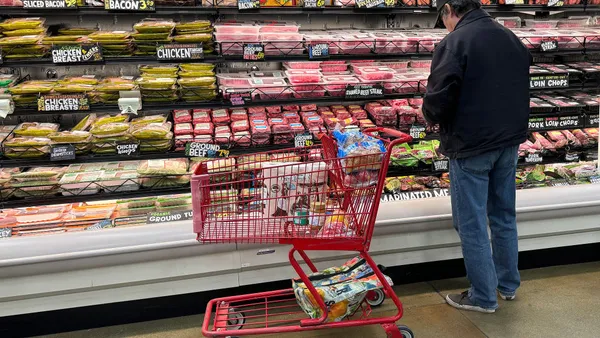Traditionally, store replenishment and DC/warehouse inventory management have been separate processes driven by separate demand forecasts. A recent RELEX survey found that 16% of large US grocers still base their DCs’ forecasts on their own historical outbound delivery data. The majority — about 70% of respondents — reported that they based DC forecasts on store demand forecasts. While preferable to looking at outbound deliveries alone, there are still significant disadvantages to this poorly integrated approach.
- The timing problem: For stores to have product on their shelves to sell, there must first be an accurate DC forecast that can account for changing demand on the store, product and even day-levels. However, there are also variations in stores’ sell-through rates and replenishment schedules which affect store forecasts. All this variability amounts to bad news for DC forecast accuracy.
- Outbound peaks: When goods are pushed rather than pulled through the supply chain, distribution centers experience outbound peaks that don’t correlate with store forecasts. Consider promotions for example, where anywhere from 30–100% of the expected uplift must be pushed to stores before the promotion starts and demand rises in store. A promotion causes a much larger initial demand peak at a distribution center than it does in stores. While the retailer may “control” this peak, it requires too much manual planning and guesstimating by DC supply planners trying to anticipate when and in what quantities stores will take in a promoted product.
Supply chain projections enable seamless integration
The best practice is to base DC forecasting on stores’ projected orders, which reflect both pull-based demand and planned, push-based stock movements. According to the RELEX survey, though, only 14% of responding grocers have actually implemented this approach.
To integrate store and DC planning, your planning system must be able to calculate projected store orders per product, per store and per day, all well ahead of time — by months or even a whole year. These order projections must build on the demand forecast by incorporating current and known future replenishment parameters as well. These calculations, of course, require significant data processing capacity, which is a likely explanation for the surprisingly low adoption rate.

In an integrated supply chain, the distribution center shipment plan replaces traditional methods for DC forecasting. The DC shipment plan is based on stores’ order projections, including pull-based demand, planned push-based stock movements and forecasts for direct DC-to-customer shipments.
Store order projections consolidate large amounts of data, including current inventory, safety stock levels, visual minimums, replenishment schedules and planned inventory movements like stock being pushed to stores before promotions. Aggregated across stores, these order projections help distribution centers generate accurate, customer-driven DC forecasts.
The value of basing DC forecasts on store order projections is evident in many scenarios — for example, new product introductions. During a new product launch, distribution centers push at least one case pack or enough product to fill the allocated shelf space at each store. This creates inventory surpluses that can take days or weeks to sell through. However, as long as a store has surplus inventory, its projected orders (and the DC outflow) will be lower than the forecasted demand, maintaining the optimal stock balance at each store location.
This example demonstrates why basing DC forecasts on projected store orders is so useful when ramping stock up or down — from product introduction and termination to promotions, seasons and changes in replenishment schedules.
An integrated supply chain eliminates double planning
Store order projections and the DC forecasts they inform automatically reflect the effects of planned changes in store replenishment. When stores plan for promotions, seasons, assortment changes or changes in replenishment schedules, that impact is immediately visible in the DC forecast for the right dates and in the right quantities.
Of course, none of this is possible without a planning system equipped with the necessary functionality and data processing capability. The real challenge, though, is getting the whole organization to work proactively. Ensuring that decisions are made early enough — but not so early they hinder flexibility — requires that everyone in the organization have a basic understanding of how the supply chain works and what the relevant lead times are for different types of changes.
So, do you have a good reason for not integrating your supply chain?









